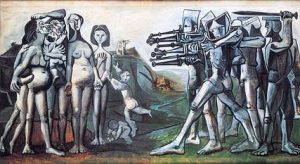6 October 1 – The Other Korean War

- VoiceThread, “The Other Korean War”
- Heonik KWON, After the Korean War: An Intimate History, 1-8
- KIM Min-suk, “Scarlet Fingernails,” 79-114
The focus of Thursday’s class are the long-term effects of the Korean War on people’s lives in South Korea.
- The Heonik Kwon excerpt provides a concise but rich conceptual framework for understanding this topic.
- The VoiceThread presentation provides more historical and contextual information on the “Other Korean War”
- Kim Min-suk’s short story “Scarlet Fingernails” provides an intimate portrait of the “Other Korean War”
Note: The VoiceThread presentation is fairly lengthy. For this reason, we will have a 60-minute class this Thursday (11:00 am-noon, CT; noon-1 pm Indiana time). If you haven’t already gained access to VoiceThread, be sure to request permission before Wednesday night, as I might not receive your request till Thursday morning. To gain VT access, click this link.
Note 2: There will be no Homework for Wednesday night, but do come ready to discuss “Scarlet Fingernails” in conjunction with the key ideas from the Heonik Kwon reading.
Questions to consider as you read “Scarlet Fingernails”:
- How does the prevailing belief in anticommunism shape what (as a girl) knows about her father?
- How do anticommunist values and regulations affect other characters in the story?
- How is Sŭng-hye’s life affected by her father’s background? How is her mother’s life affected? How is their (mother-daughter) relationship affected?
- Why are relations strained between Sŭng-hye’s mother and her in-laws? Why are relations strained between Sŭng-hye and her mother?
- Do you think Sŭng-hye’s father is a “true believer” in communism (a “committed communist,” p. 102)?
- Observe how the primacy of the male line (as a prevalent, traditionalist value) appears in the story.
- What intersections/contrasts do you see between the story and the Heonik Kwon essay? Between the story and Parade of Wives?
Here is some information relevant to “Scarlet Fingernails“:
- Mentioned in the short story and in Grandmother’s Flower, the National Security Law (NSL, Gukka boanbeop) was promulgated in South Korea in the aftermath of the Yeosu-Suncheon Uprising of 1948. Together with the Jeju Uprising of 1948-49, this mutiny was an important early challenge to the legitimacy of the Syngman Rhee regime. It equipped the authoritarian state with broad powers to suppress (often following quick, unfair trials) intellectuals, activists, and others who held views that dissented against the government and its policies. The NSL was revised a number of times over the decades, but remains in place today, even after the democratic transition of 1987.
- The Anticommunism Law (Bangongbeop), which is mentioned in “Scarlet Fingernails,” was promulgated in 1961 shortly after the rise of PARK Chung Hee. It was repealed in 1980 following Park’s assassination, but certain articles of the law were folded into the NSL. The Anticommunism Law further bolstered the authoritarian state’s ability to crack down on dissidents, whether or not they actually held communist views.
- Traditionally, each generation within a clan is assigned a Chinese character (dollimja) that is to form part of the name of each child born into that generation. Reflecting this, Sŭng-hye (the protagonist in “Scarlet Fingernails) shares the character “sŭng” with her cousins and half-brothers of the same generation: Sŭng-jae, Sŭng-ho, Sŭng-o, etc. The sharing of the dollimja is only by kin of the same generation related patrilineally. So, for example, if Sŭng-hye were to have a maternal cousin (for example, her mother’s sister’s son), that male cousin would not share the same “sŭng” character. Dollimja are still shared by kin of the same generation in a lot of families.
- During the Joseon era, widow chastity (widows remaining faithful to their deceased husband by not remarrying and, in certain cases, remaining in their husband’s household) was viewed as one of the preeminent examples of womanly virtue. The Joseon state even bestowed honors on exemplary chaste widows, which reflected well not only on the woman but also on her husband’s family. Although widow’s chastity is no longer promoted as a social ideal in South Korean society, Sŭng-hye’s mother’s decision not to remarry may be seen as partially the influence of this Confucian value.
- In contrast to this situation for women, Joseon-era men were allowed to take concubines and to remarry (if their wife died). One reason why men were allowed to remarry and to take on a concubine was because of the importance of producing a male heir to continue the family line.
